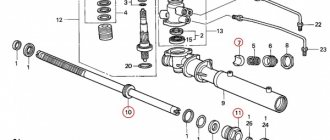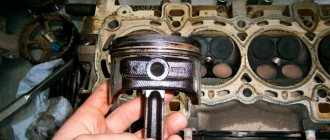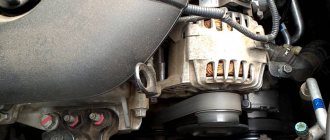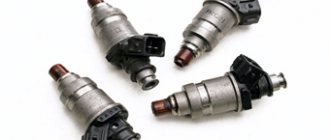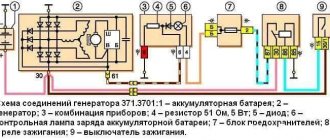Without an engine and body there is no car. This old driver's saying has a point. Replacing a rotten or dented body is always expensive, and without a working engine the car will stop working. The most important sign of imminent engine death is an extraneous sound from under the hood.
In this article we will tell you in detail about knocking in the engine and what it means.
Most often, the characteristic dull sound under the hood occurs due to a gap between the parts inside the engine. If you hear a loud knock, then the permissible distance between parts has been exceeded by 2 or more times. The louder the sound, the more the gap “grows” and the faster the wear of the insides of the unit.
Why the knocking appeared and what changes await the engine depends on the quality of the parts and operating conditions. In any case, the consequences are sad:
- excessive loads and increased detonation;
- constant heating of the working mixture and loss of its qualities, which causes engine parts to wear out faster.
Diagnosis of engine knocking
Checking the condition of the motor when knocking occurs is carried out according to several parameters.
- According to the nature of the sound: constant, rare or episodic - the frequency of tapping depends on the type and degree of malfunction.
- By tonality: determining the tonality of a sound is not an easy task. Only an experienced technician can understand that the loud knocking sound of an engine in a Korean car and the muffled sound of a higher-power engine in a German car mean essentially the same thing - a faulty crankshaft bearing. The fact is that structurally different engines can sound differently, regardless of condition.
- By location: to obtain the most reliable data, specialists use a stethoscope, but if the device is not at hand, you can make a listening device from scrap materials. For example, from a tin can and steel wire.
Engine knocking is inextricably linked to the operation of the crankshaft, which ensures engine speed. Accordingly, the faster the crankshaft rotates, the more often the knocking sound is heard in the engine. Depending on the operating mode of the internal combustion engine, the sound may be louder or quieter. It is important to accurately establish the relationship between the increase in engine speed and sound intensity.
During the diagnostic process, it is necessary to check at what point in operation the engine knocks louder. It often happens that at high temperatures in the system (at the moment when the engine oil is most liquid and increased in volume), the power plant knocks loudly. In some cases, knocking is heard precisely when the engine is cold, and after warming up the noise completely disappears or becomes almost unnoticeable.
When starting from cold
If a knocking noise starts when you start the engine at a cold temperature, this is due to the viscosity of the oil on a cold engine, especially for this reason the noise of the expansion joints occurs.
If the driver changed the oil, he heard knocking noises in the engine when starting up. This is a normal phenomenon, since the oil was drained during replacement, and the new oil has not yet had time to completely enter the lubrication system. For some time the engine runs with oil starvation, as a result. To speed up the oil filling process, all engine lubrication systems are filled with oil before changing a new oil filter.
When the oil level in the crankcase decreases, an incomprehensible noise also appears in the engine, gradually increasing as it warms up below. When hot, it intensifies with increasing speed and these are signs of oil starvation of the connecting rods and piston pins.
Causes of engine knocking
If immediate action is not taken, the knocking noise in the engine may intensify. In the systems of the gas distribution mechanism, cylinder-piston group and crank mechanism, knocking can occur:
- piston in cylinder;
- piston pins;
- camshaft in the block head;
- directly the crankshaft in the cylinder block;
- the so-called rocker arm, as well as the axis of the valve mechanism;
- valve and valve guide;
- valve and cylinder head (cylinder head).
If timing parts (chain or belt), made of hard and sufficiently durable materials, are worn out, the knocking noise can continue for a long time. The destruction of the softer elements that function in tandem with the metal bearings and liners will cause the sound to begin to intensify.
The most dangerous causes of knocking
1. Pistons are knocking in the cylinders.
The knocking of the piston, distinguished by a dull tone, is clearly audible in the cylinder block and is sometimes accompanied by a kind of clicking sound.
The engine knocks and clatters as a result of thermal expansion of the piston, usually “in the cold,” at low engine speeds, as well as when the gas is suddenly released while driving. A knock occurs as soon as the gap becomes larger than 0.3 mm. 2. The piston pins are knocking.
The sound of the piston pins knocking is “metallic”, high-pitched and slightly ringing. This sound is clearly audible if you over-throttle or press the accelerator hard to accelerate. The place where the sound occurs is considered to be the cylinder block; the gap is about 0.1 mm.
The malfunction can also be determined by unscrewing the spark plug. Without a spark plug, the fuel in the cylinder does not burn, which means there is no load on the piston.
Detonation often occurs due to the use of fuel that is unsuitable for this type of engine, as well as during extreme overloads (steep uphill, long descent).
3. Main bearings and crankshaft liners are knocking.
The metallic knock of the engine, characteristic of this case, is a little muffled and is heard from the crankcase. Knocking elements are especially audible at low speeds of a “cold” engine during acceleration and at the moment of releasing the gas. The size of the gap between the neck and the liner is equal to the minimum 0.1-0.2 mm. A drop in oil pressure to a critical level makes the sound louder, regardless of the operating mode.
Often, valve knocking is caused by the use of low quality motor oil, or one that does not match the type of power unit.
4. Connecting rod bearings are knocking.
The sound of faulty connecting rod bearings is similar to signs of main bearing problems, but is more distinct. If the sound intensity increases, repairs must be made urgently. Operation of both gasoline and diesel engines with unsuitable connecting rod bearings is prohibited - the engine may “seize” at any time.
FakeHeader
Comments 43
And what stops you? You will start it on a cold internal combustion engine, the only power will be from the battery and the internal combustion engine will not even have time to warm up for a short time.
How to remove, and, most importantly, how to tighten the belt back when the car is on the street, without a lift, etc.?
But if on a warm engine, you raise the speed to the levels at which this sound is present when starting on a cold one, is the sound heard or not? it’s just very similar to the vibration of some sheet of iron, engine protection, exhaust manifold screen, etc. After warming up, the engine runs quieter and it is quite possible that the vibration disappears
When warmed up, the sound disappears completely and does not appear at any speed. There was no protection during shooting, I also checked the manifold screen, touched all the plastic on the cylinder head cover - that’s not it...
Tensioner or roller in it
If you want to know exactly what it is. remove the attachment belt. It's a matter of internal combustion engines or mounted ones, I think it will be beautiful.
This is a 100% attachment belt tensioner. There is a small shock absorber in it. There is a bushing in it when it wears out in cold weather and then in warm weather it starts knocking on the tensioner mount... I did the budget option, I just removed it, machined the bushing and changed it
Can you tell me more about the budget option?
Remove the belt and start it cold to make sure there is no sound. If everything is fine, remove the generator, pump pulley, and the tensioner itself along with the pulley. You will immediately see the hardening from the bushing on the tensioner itself. Next to the turner, I machined the bushing from caprolon
On Friday, I removed the belt and touched the tensioner itself. He's loose. Moreover, the play is perpendicular to the plane in which the tensioner is installed. It looks like the bushing through which the tensioner is attached to the engine has run out. Looks like we'll have to change...
The sound seems to be out of sync with the engine. Tried accelerating, does the frequency change? But of course this sound is better for Honda drivers. OD for example
I went to the OD a month ago, changed the pillows and underwent diagnostics. The valves were adjusted, by the way. Nothing criminal was found. There is no OD in our region, the nearest one is in Kazan, 150 km away. But I went to Nizhny Novgorod, 250 km away. I tried accelerating: at first the volume of this sound increases slightly, but as the speed increases, the sound disappears and returns again when the speed drops to idle. And so on until the engine is completely warmed up. After warming up, the sound is as good as ever. The engine runs smoothly. If you start driving without warming up the engine at all, then, at first, you feel like you’re driving a diesel tractor, or, well, with a broken muffler...
Drivers are often interested in why crackling and grinding noises are heard when starting the engine. There may be several reasons for this phenomenon. In any case, the source of this sound should be eliminated as quickly as possible. Otherwise, you risk a breakdown at the most inopportune moment. In general, if any strange sounds appear, you should check their origin. After all, this is most likely a sign of a breakdown.
The sooner you eliminate it, the better. After all, most faults can cause a chain reaction. And provoke breakdowns of other engine components. Therefore, always listen carefully to the operation of the power unit.
Engine repair tips
If a distinct knocking sound appears in the engine, be sure to check the engine oil level; its drop in the lubrication system can lead to malfunction of the entire internal combustion engine system. If the level is optimal, determine where the sound is located. At this stage, you need to make sure that the following are in working order:
- fuel system;
- drives;
- attachment pulleys.
The next step is to determine the characteristics of the knock. If a “loaded” engine knocks more strongly, most likely, problems have appeared in the crank mechanism or in the cylinder-piston group.
If you notice that the knocking frequency does not coincide with the crankshaft rotation speed (it differs by about 2 times), then the probable problem must be looked for in the timing system. The fact is that the crankshaft rotation speed is 2 times higher than the camshaft rotation speed. When the engine warms up, the knocking noise usually gets worse because the clearances in the valve mechanism become larger as the engine heats up. The gas distribution mechanism, on the contrary, is not related to the operating mode of the engine. As an exception, we can recall cases of hydraulic compensators knocking under load.
Increased knocking can also occur due to heating and subsequent expansion of the engine oil, which indicates a problem with the bearings of the crankshaft mechanism.
The specialists of the official FAVORIT MOTORS service center will help you troubleshoot any engine design.
The experience and professional knowledge of our specialists can quickly and inexpensively return your vehicle to good condition using original spare parts, consumables and modern equipment. All work is carried out with a guarantee and in accordance with the manufacturers' recommendations. Sign up for service Service center contactsAsk a question
Starter
There are several reasons for this behavior. In order to understand the reasons in more detail, you need to know the starter design and operating principle. It consists of an electric motor, on the shaft of which an overrunning clutch with a drive gear is installed. In everyday life, the clutch and gear are called bendix. The design also includes a starting relay with a solenoid. This design is called a “traction relay”. It is connected to the clutch by the starter activation lever.
This design works as follows
. When turned on, the electric motor begins to rotate the bendix. At the same time, the traction relay, having activated, moves the overrunning clutch forward using a lever.
As a result, the gear meshes with the teeth of the flywheel and spins the engine. After the engine starts, the overrunning clutch is activated. This protects the starter from damage. When the power supply to the device is turned off, the relay stops working and the starter bendix returns to its original position. Passenger car starters usually use a roller-type overrunning clutch.
There is only one reason for the grinding noise at startup. For some reason the Bendix cannot fully engage the flywheel. Therefore, when starting the starter, a grinding sound of skipping teeth occurs. This problem needs to be fixed as quickly as possible. Otherwise, the flywheel and starter gears may be damaged. You need to check the following points:
- First, check the starter mounting. Sometimes vibration can cause the mounting bolts to come loose. In this case, the starter becomes warped and the gear loses full contact with the flywheel. In any case, remove the starter and check the condition of the bendix;
- Sometimes the problem can be caused by gear wear. In this case, the starter's performance decreases. When starting the engine, you will hear the grinding sound of the bendix moving around. Over time, the starter will not be able to turn the flywheel at all. After removing the part from the machine, you can see the gear wear with the naked eye;
- Sometimes the Bendix does not move well along the shaft and simply does not reach the flywheel. In this case, remove it. You need to coat the shaft with any motor oil (5w30 or 5w40 or whatever you have on hand). Also check the operation of the traction relay.
These are the main causes of a grinding noise at startup associated with this particular part. Most often you will find the problem somewhere in the starter.
A crackling sound when starting can also occur due to problems with the starter's power supply. It appears when the positive wire is loosened. If there is poor contact, a spark discharge occurs, which is what produces a crackling sound. Check the wire. Tighten it if necessary.
Flywheel
. The cause of the grinding noise may be in the engine. If the flywheel teeth are worn too much, they cannot form full contact with the starter gear. As a result, you can hear an unpleasant grinding noise. It is advisable to replace the flywheel. Otherwise, wear on the bendix will increase and you will have to change it regularly.
Since we're talking about the flywheel, read our two materials on this topic:
- “Pros and cons of a lightweight flywheel”;
- “Independent replacement of a dual-mass flywheel with a single-mass one.”
Roller mounting bolt (timing)
. Sometimes the timing drive pulley may come loose. At the very beginning of this process, a grinding noise is observed immediately after the engine starts. After warming up everything goes away. It is recommended to tighten the bolt properly. This problem often occurs on the tenth VAZ family.
Conclusion
. A faulty motor can make a variety of sounds. Therefore, it is important to know the main causes of these phenomena. At the same time, drivers are often frightened by the simplest things and ask why crackling and grinding noises are heard when starting the engine. The answer to this question is quite simple. In most cases, the cause of these unpleasant sounds is the starter, or rather its elements.

